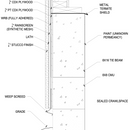Recladding With Stucco
Stucco wall assembly climate zone 2A
Hello,
I am remodeling my 1980 house in Climate Zone 2A. I want to change the exterior to stucco. After a lot of research on GBA and other great resources I think I have a pretty good assembly. In short it’s 1/2 plywood with fully adhered WRB (Adhero – 7 perm), 1/4 rainscreen (Benjamin Obdyke Slicker Max) and 3 coat stucco rendering.
I have two questions.
1) My local building code calls for a second grade D building paper. The slicker max rain screen has a filter fabric that blocks mortar droppings from seeping into the cavity. Does this qualify as a second layer of building paper or do I need to add a layer of Tyvek. If that’s the case where should that layer be.
2) As you can see from the attached drawing my foundation wall is extending quite a bit above grade. I would like the stucco to hide that fact and go all the way down to 4 inch above grade. The best way I can think of to accomplish this is to run plywood along the foundation so I have at least the same substrate flush from top to bottom. I plan on using pressure treated plywood but my question is if I should install a layer in between the plywood and the foundation to break capillarity. If so – what material would you recommend. Obviously it needs to be vapor closed to break capillarity, but do I need to worry about not allowing the concrete foundation to dry to the outside anymore.
Thank you so much for your comments.
Niko
GBA Detail Library
A collection of one thousand construction details organized by climate and house part










Replies
1. The filter fabric should satisfy any reasonable inspector as far as a second layer of Grade D. That said, the final answer comes from your building dept. and you would be doing yourself a favor to check with them. You can also buy stucco mesh with its own backing, which is quick and easy to put up if they hassle you.
2. Your termite shield detail is problematic. You definitely need to stop the wall stucco at the sill plate and the shield needs to extend out from that. The shield doesn't actually prevent termites from entering your wall. It forces termites coming up the outside of your foundation to go around it, thus exposing their soil tunnels and making them visible.
One approach to achieving a suitable finish on your concrete would be a simple one-coat stucco applied to the face of your foundation wall. This would at least match the color and texture of the wall above. However it would be an inch or so recessed from the wall face above. If that's a problem that you could glue a layer of rigid foam to the foundation face and give that a stucco coat. This would bring it out to flush or slightly beyond, compared to the wall above. The foundation finish surface and the wall finish surface would be separated by the termite shield, which would be visible. You could prefinish the shield to match your wall color, to make it a bit less conspicuous.